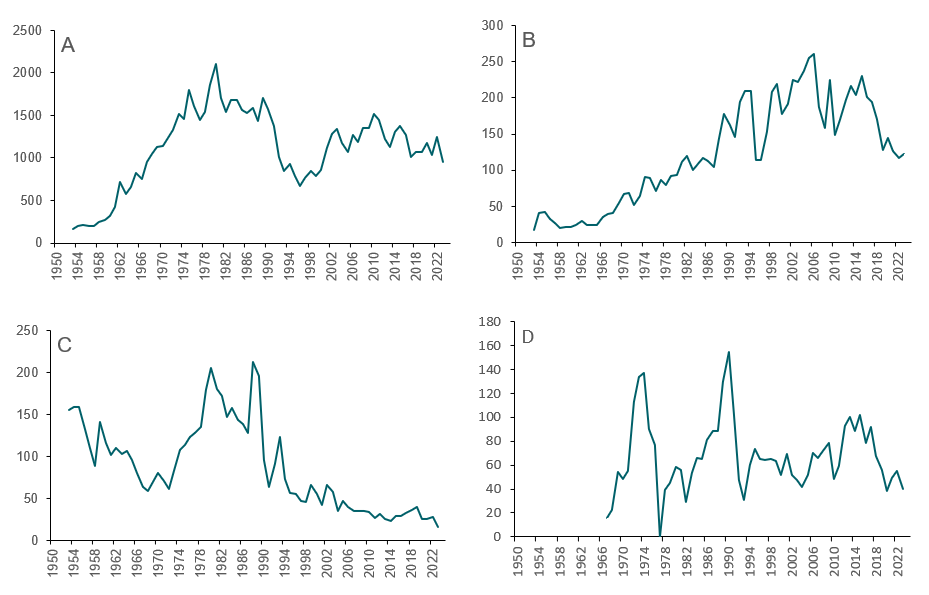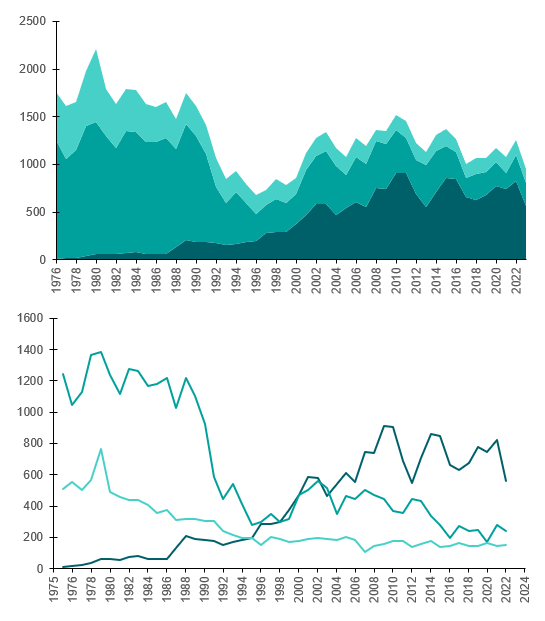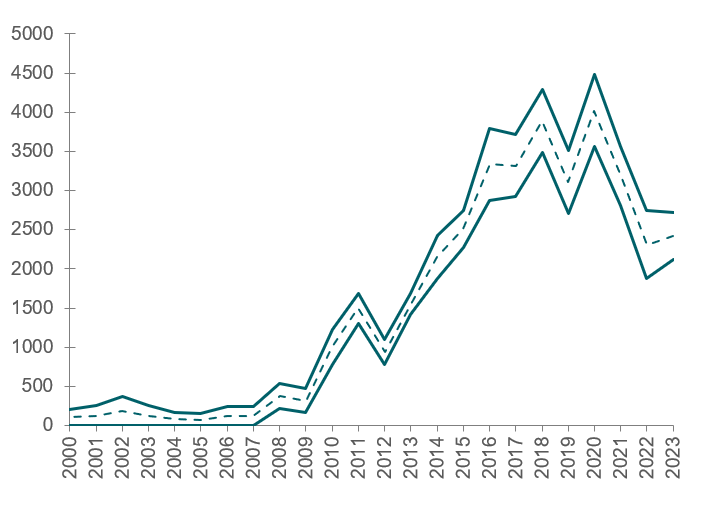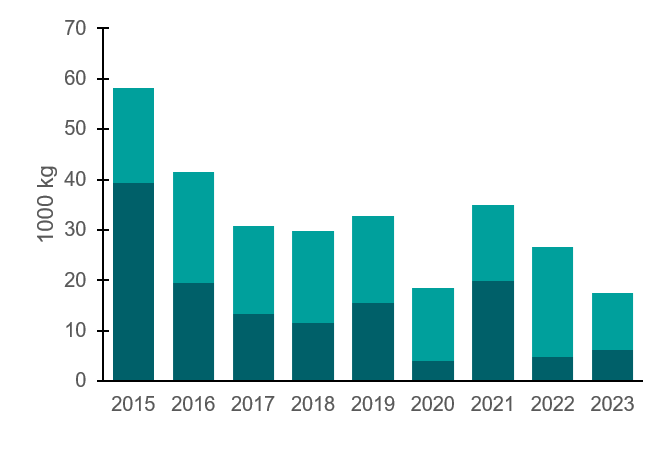Sales volumes of plant protection products
Data on the sales volumes of plant protection products are published annually in January–February. Statistics on the sales volumes in Finland have been collected since 1953. Tukes has been responsible for compiling the statistics on sales volumes since 2011.
The majority of plant protection products placed on the market in Finland consists of urea intended for use in forestry, which is processed separately in the statistics. The sales volume of other plant protection products, mainly intended for use in agriculture and horticulture, has remained at around 1,300 tonnes of active substance in recent years.
The annual sales volumes of product groups are as follows:
- The sales volume of plant protection products intended for weed control, i.e. herbicides, is approximately 1,096 tonnes of active substance (5 year average).
- The sales volume of plant protection products intended for plant disease control, i.e. fungicides, is approximately 128 tonnes of active substance (5 year average).
- The sales volume of plant growth regulators is approximately 48 tonnes of active substance (5 year average).
- The sales volume of plant protection products intended for pest control, i.e. pesticides, is approximately 27 tonnes of active substance (5 year average).

Figure 1: Sales volumes of herbicides (A), fungicides (B), pesticides (C) and growth regulators (D) in 1953–2023. The data are presented in tonnes of active substance. (Excel file, 46 kB)
Sales volumes of different herbicide groups have changed significantly over the last 40 years. Sales of glyphosate have grown steadily since the 1970s. Today, the annual sales of glyphosate are roughly 700 tonnes of active substance. The sales volume of phenoxy herbicides has decreased correspondingly. The most significant change took place at the turn of the 1990s, when chemical isomers that were ineffective in weed control were removed from the active substances. The sales volume of phenoxy herbicides has decreased from more than 1,000 tonnes of active substance in the early 1980s to about 200 tonnes of active substance today.

Figure 2: Sales of glyphosate, phenoxy herbicides and other herbicides in Finland in 1976–2023. The data are presented in tonnes of active substance. (Excel file, 31 kB)
Products used in forestry cannot be unambiguously identified in the statistics. Sales volumes are collected by product, and each product can have several different uses in agriculture and forestry. However, urea products are exclusively uses in forestry, and total sales increased significantly from the early 2000s to 2020. Urea-containing products were started to be marketed as plant protection products in 2003. Their sales passed other products in 2012, with urea products accounting for as much as 74% of the sales volume of all plant protection products in 2020. Urea is used in root rot control, which is mandatory at most softwood-dominated logging sites in Southern Finland during the growing season.

Figure 3: Sales of products intended wholly or partly for use in forestry in 2000–2023. The sales volume of products used partly in forestry is presented as a range, because the actual volume of use is unknown. The data are presented in tonnes of active substance. (Excel file, 29 kB)
Since 2015, products have been approved for consumer or professional use. Consumer products account for less than 1% of total sales. The sales of glyphosate products decreased between 2015 and 2020 and were replaced by herbicides containing various carboxylic acids (e.g. pelargonic, caprylic, capric or acetic acid).

Figure 4: Sales of insecticides and fungicides and herbicides intended for consumer use in 2015–2023. The data are presented in tonnes of active substance. (Excel file, 29 kb)
How the statistics are compiled
Tukes must send data on the sales volumes of active substances contained by plant protection products and a description of the data collection method annually to Eurostat, the statistical office of the EU. The data provided must be grouped in accordance with the EU regulation concerning statistics on pesticides (EC 1185/2009).
Holders of plant protection product authorisations must report the previous year’s product sales volumes to Tukes every year by 31 March. Since 2021, data have been collected directly through the KemiDigi system.
Access to microdata
The data on product sales volumes submitted to Tukes are confidential (Act on the Openness of Government Activities (621/1999; section 24, subsection 1, paragraph 20). Sales volumes of active substances are similarly processed as confidential data if these volumes can be indirectly linked to a specific authorisation holder or product. Tukes cannot publish confidential data without the data submitter’s approval, but a right of use can be granted for data on sales volumes of active substances for research or statistical purposes or for the planning or investigation activities of the authorities. According to the Act on the Openness of Government Activities, the general period of confidentiality is 25 years. Tukes collects data on sales volumes for EU statistics and is also obligated to follow statistical confidentiality in its activities (EU statistics regulation (EC) No 223/2009, article 20).
Currently, data on volumes between 1953 and 1998 are only available in Tukes’ physical archives, and they are not available in electronic format.
For the right to use confidential data, an application for obtaining data from the authorities’ confidential documents must be submitted to the Tukes registry office ([email protected]). Tukes will process the application and prepare an appealable decision. A fee in accordance with the Tukes price list can be charged for the processing of data requests.
Legislation
EU Plant Protection Product Regulation (1107/2009)
EU Regulation concerning statistics on pesticides (1185/2009)
EU statistics regulation ((EC) No 223/2009)
Act on plant protection products (1563/2011)
Act on the Openness of Government Activities (621/1999)
See also
Natural Resources Institute Finland (Luke):
- Data on the volumes of use of plant protection products collected every five years
Statistics on the sale and use of plant protection products in the EU Member States (Eurostat):
- Pesticide sales database, Pesticide sales metadata
- Pesticide use in agriculture database, Pesticide use in agriculture metadata
- Harmonised risk indicator database, Harmonised risk indicator metadata
Statistics on the sale of plant protection products globally:
- FAOSTAT
- Our World in Data: Pesticides
Historical data on the use of plant protection products in Finland:
- Annual issues of the journal of technical chemistry and the Kemia-Kemi journal until 2003.
- Plant protection products in agriculture and forestry in 1953–1987